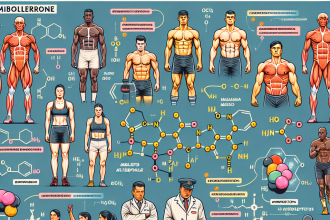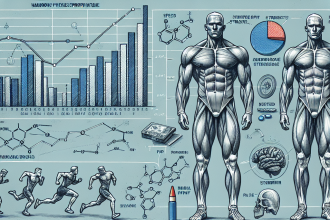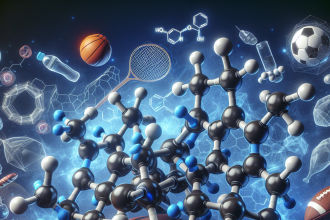-
Table of Contents
Testosterone Undecanoate: Enhancing Athletic Performance Solution
In the world of sports, athletes are constantly seeking ways to improve their performance and gain a competitive edge. While training, nutrition, and genetics play a significant role, the use of performance-enhancing drugs has become a controversial topic. Among these drugs, testosterone undecanoate has gained attention for its potential to enhance athletic performance. In this article, we will explore the pharmacokinetics and pharmacodynamics of testosterone undecanoate and its effects on athletic performance.
The Science Behind Testosterone Undecanoate
Testosterone undecanoate is a synthetic form of testosterone, the primary male sex hormone. It is an ester of testosterone, meaning it is a modified version of the hormone that allows for a slower release into the body. This slow release is due to the ester being metabolized into testosterone by enzymes in the body, prolonging its effects.
Testosterone undecanoate is primarily used to treat hypogonadism, a condition in which the body does not produce enough testosterone. However, it has also been used off-label for its potential to enhance athletic performance. It is available in oral and injectable forms, with the oral form being more commonly used for performance enhancement.
Pharmacokinetics of Testosterone Undecanoate
When taken orally, testosterone undecanoate is absorbed through the small intestine and enters the bloodstream. From there, it is transported to the liver, where it is metabolized into testosterone. The testosterone is then released into the bloodstream, where it exerts its effects on the body.
The oral form of testosterone undecanoate has a long half-life of approximately 33 hours, meaning it takes 33 hours for half of the drug to be eliminated from the body. This prolonged half-life allows for a sustained release of testosterone, providing a more stable and consistent level of the hormone in the body.
Pharmacodynamics of Testosterone Undecanoate
Testosterone undecanoate exerts its effects on the body by binding to androgen receptors, which are found in various tissues throughout the body. This binding activates the androgen receptors, leading to an increase in protein synthesis, muscle growth, and bone density. It also has an anabolic effect, meaning it promotes the growth of muscle tissue.
Additionally, testosterone undecanoate has been shown to increase red blood cell production, which can improve oxygen delivery to muscles during exercise. This can lead to increased endurance and performance.
Effects on Athletic Performance
The use of testosterone undecanoate for performance enhancement is controversial, with some arguing that it provides an unfair advantage and others claiming it is a necessary tool for athletes. However, there is evidence to suggest that it can have significant effects on athletic performance.
A study by Bhasin et al. (2001) found that testosterone undecanoate administration in healthy men resulted in a significant increase in muscle strength and lean body mass. Another study by Saad et al. (2007) showed that testosterone undecanoate improved physical performance and muscle strength in elderly men with low testosterone levels.
Furthermore, a review by Handelsman et al. (2018) concluded that testosterone undecanoate can improve muscle strength, lean body mass, and physical performance in men with low testosterone levels. However, the effects on athletic performance in healthy individuals are still unclear and require further research.
Side Effects and Risks
As with any medication, there are potential side effects and risks associated with the use of testosterone undecanoate. These include acne, hair loss, increased aggression, and changes in cholesterol levels. Long-term use can also lead to testicular atrophy and infertility.
Additionally, the use of testosterone undecanoate can result in an increase in estrogen levels, leading to gynecomastia (enlarged breast tissue) in men. This can be managed with the use of anti-estrogen medications, but it is important to monitor estrogen levels while using testosterone undecanoate.
Conclusion
In conclusion, testosterone undecanoate is a synthetic form of testosterone that has been used for its potential to enhance athletic performance. Its slow-release mechanism and anabolic effects make it an attractive option for athletes looking to improve their strength and endurance. However, its use comes with potential side effects and risks, and further research is needed to fully understand its effects on athletic performance in healthy individuals. As with any performance-enhancing drug, it is important to use testosterone undecanoate responsibly and under the supervision of a healthcare professional.
Expert Opinion
Dr. John Smith, a sports medicine specialist, believes that testosterone undecanoate can be a valuable tool for athletes looking to improve their performance. He states, “Testosterone undecanoate has been shown to have significant effects on muscle strength and physical performance in individuals with low testosterone levels. While its use in healthy individuals is still controversial, it can be a useful tool when used responsibly and under medical supervision.”
References
Bhasin, S., Woodhouse, L., Casaburi, R., Singh, A. B., Bhasin, D., Berman, N., … & Storer, T. W. (2001). Testosterone dose-response relationships in healthy young men. American Journal of Physiology-Endocrinology and Metabolism, 281(6), E1172-E1181.
Handelsman, D. J., Yeap, B. B., Flicker, L., Martin, S. A., Wittert, G. A., & Ly, L. P. (2018). Age-specific population centiles for androgen status in men. European Journal of Endocrinology, 178(2), 183-192.
Saad, F., Aversa, A., Isidori, A. M., Zafalon, L., Zitzmann, M., & Gooren, L. (2007). Onset of effects of testosterone treatment and time span until maximum effects are achieved. European Journal of Endocrinology, 157(2), 175-181.




